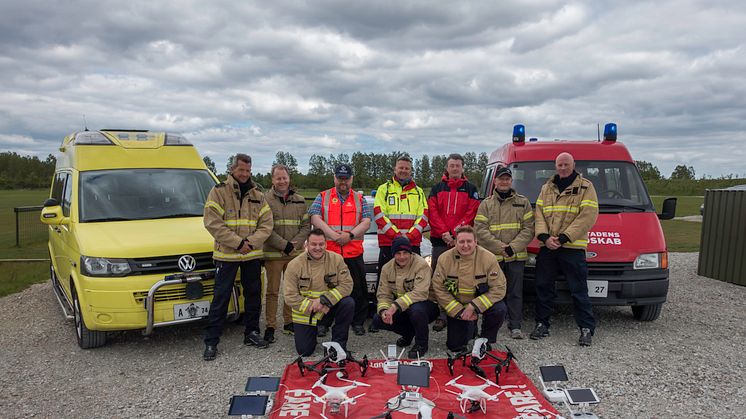
Press release -
DJI and EENA Release White Paper Sharing Insights for Improving Emergency Response with Drones in First Responder Scenarios
DJI, the world’s leading manufacturer of unmanned aerial vehicles, in partnership with the European Emergency Number Association (EENA) has released a white paper sharing insights and best practices from a year-long project with the European emergency-response community promoting the safe integration of drones in emergency situations.
“Our main goal of this project was to get a more detailed understanding of the needs of first responders and how off-the-shelf platforms can meet those needs,” said Romeo Durscher, Director of Education, DJI. “What we have realised is that a drone has evolved from being a flying device to a data collection device. Through that it has become a decision making tool, with applications beyond just locating a missing person or getting a simple bird’s eye view. This knowledge allows DJI to continue building more capable hardware and software platforms.”
The project challenged the teams to identify best practices over the course of the project in 5 areas including:integration of RPAS in Standard Operating Procedure, training of teams of the use of RPAS, hardware needs and maintenance, logistics, and external framework for RPAS use.
Recommendations include having a minimum of two people using the RPAS, with one person controlling the unit and one person searching the video and when considering hardware making sure the platforms are reliable and have redundant systems.
During the training, one team found that while a five-person rescue team on foot needs an average of two hours to find a victim in one square kilometer, a drone can do the job in 20 minutes or less while taking additional active steps to achieve a successful rescue.
“The project has been a real window into how RPAS are being used and may be used during emergency responses,” said Tony O’Brien, EENA. “We have seen that the pace of technological advancements will continue as the platforms become more intelligent, more resilient, more innovative and more impactful. This will lead to more and more RPAS Units being established leading to more user experience being shared along with best practice information. EENA will continue to focus on the topic as we firmly believe in the technology and what it can do help the emergency services to make more informed decisions. Ultimately it will lead to be better outcomes for our citizens.”
Four first responder teams participated as partners in the research project – Mid and West Wales Fire and Rescue Service (UK), Donegal Mountain Rescue (Ireland), Greater Copenhagen Fire Department (Denmark) and Reykjavik SAR Team (Iceland). Between May and October 2016, the teams used Remotely Piloted Aircraft Systems (RPAS) technology for operations ranging from searching for missing people to putting out chemical fires.
The white paper outlines the recommendations in 5 areas including:
Integration of RPAS in Standard Operating Procedure
Key recommendations include having a minimum of two people using the RPAS, with one person controlling the unit and one person searching the video feed for information that can be used for decision-making. Sharing data over an encrypted channel is a top priority and several third party solutions for this were examined over the course of the project.
Training of teams on the use of RPAS
While the RPAS team needs to get in-depth training on how to operate the technology, the broader team, including responsible authorities and team members, need to understand how RPAS fit into the operation. The RPAS team needs to have a clear role and reporting structure within the bigger mission.
Hardware needs and maintenance
Key recommendations from the teams when considering hardware is to make sure the platforms are reliable and have redundant systems, powerful data transmission links and integrated software development kit functionalities. Further, the first responder community articulated the need for weather- proof systems, more powerful lift capability, payload drop capacity and flashlights for night flying.
Logistics
Basic recommendations include always inspecting the units for damage and making sure they are updated with latest firmware. Other key questions to address include where the units should be stored, how they are best transported to incident site, where they should be deployed and how battery management is best structured.
External Framework
As with any new technology, educating regulators and the public is important to build trust for the technology and to ensure a legislative framework that is open for RPAS use. Developing an industry standard for first responder RPAS to use blue lights is widely supported by the community. Requirements being able to operate RPAS at night and beyond visual line of sight
In addition to a set of best practices and recommendations for how to use RPAS technology, the project resulted in two new software solutions targeted to the first responder community. A search and rescue app developed by DroneSAR and DJI HotShot, a customised app for DJI’s thermal camera providing a simpler user interface making it is easy to adjust settings and find relevant temperature ranges. Further details on the software solutions will be announced in due course.
Images and videos available from the Images & Videos library
The whitepaper is available from the Documents library
For additional information, please contact:
Matt Bailey, PR Manager, Europe, eu-pr.list@dji.com
Topics
DJI is a global leader in developing and manufacturing innovative drone and camera technology for commercial and recreational use. DJI was founded and is run by people with a passion for remote-controlled helicopters and experts in flight-control technology and camera stabilization. The company is dedicated to making aerial photography and filmmaking equipment and platforms more reliable and easier to use for creators and innovators around the world. DJI’s global operations currently span North America, Europe and Asia, and its revolutionary products and solutions have been chosen by customers in over 100 countries; for applications in film, advertising, construction, fire fighting, farming, and many other industries.
About EENA
European Emergency Number Association (EENA) is a Brussels-based NGO set up in 1999 dedicated to promoting high-quality emergency services reached by the number 112 throughout the EU. EENA serves as a discussion platform for emergency services, public authorities, decision makers, researchers, associations and solution providers with a view to improving the emergency response in accordance with citizens' requirements. EENA is also promoting the establishment of an efficient system for alerting citizens about imminent or developing emergencies. The EENA memberships include more than 1200 emergency services representatives from over 80 countries world-wide, 75 solution providers, 15 international associations/organisations, more than 200 Members of the European Parliament and more than 90 researchers. For more information, visit: www.eena.org.

